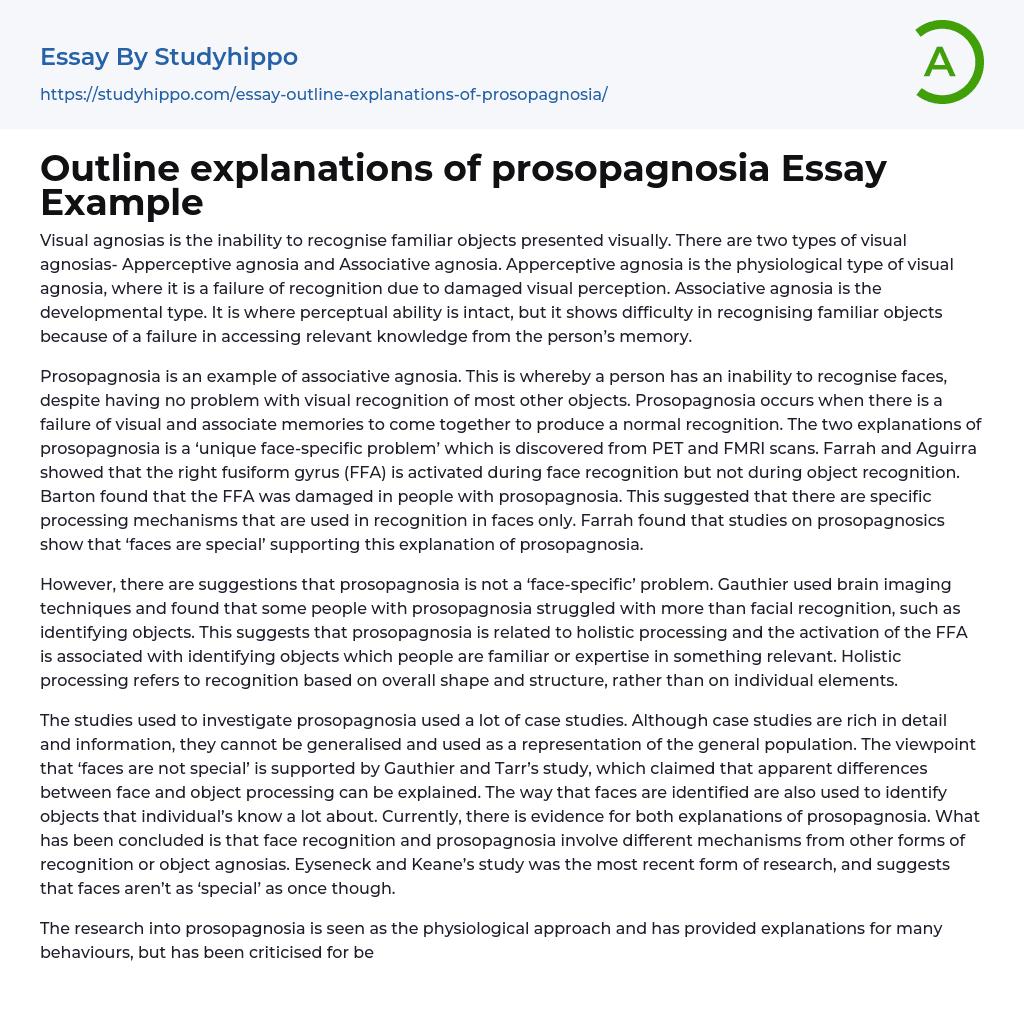Visual agnosias encompass the incapacity to visually acknowledge familiar objects, with two distinct forms: Apperceptive agnosia indicates impaired visual perception resulting in recognition challenges, while associative agnosia involves intact perceptual ability but difficulty recognizing known objects due to memory-related hindrances.
Prosopagnosia, also known as associative agnosia, is a condition in which individuals are incapable of identifying faces, despite their ability to identify other visual objects with ease. The main cause behind prosopagnosia is the inadequate integration of visual and associative memories, resulting in impaired face recognition. PET and FMRI scans have provided two explanations for this phenomenon. Farrah and Aguirra's research discovered that the right fusiform gyrus (FFA) becomes active during face recognition but not during object recognition. Barton's findings supported this by demonstrating that individuals afflicted with prosopagnosia have damaged FFA, indicating specific processi
...ng mechanisms dedicated solely to recognizing faces. Further studies conducted by Farrah on prosopagnosics demonstrated that faces hold a unique significance, further supporting the explanation of prosopagnosia.
According to suggestions, individuals with prosopagnosia, a condition characterized by difficulty in recognizing faces, may also struggle with identifying objects. Gauthier used brain imaging techniques and found that people with prosopagnosia have difficulties in recognizing objects as well. This suggests that prosopagnosia is associated with holistic processing, and the activation of the Fusiform Face Area (FFA) helps in identifying familiar or relevant objects based on an individual's expertise. Holistic processing involves recognizing overall shape and structure rather than individual components.
Case studies have been essential in the study of prosopagnosia, providing detailed information. However, these case studies cannot be generalized to the entire population. Gauthier and Tarr's research support
the notion that faces are not inherently special and argues that perceived differences between face and object processing can be explained. Additionally, the same processes used for recognizing faces also play a role in identifying familiar objects. Currently, there is evidence supporting both explanations for prosopagnosia. Nevertheless, it has been concluded that face recognition and prosopagnosia involve distinct mechanisms from other forms of recognition or object agnosias. According to Eyseneck and Keane's recent investigation, faces may not possess as much uniqueness as previously believed.
The research on prosopagnosia can be considered a physiological approach, which has offered explanations for numerous behaviors. However, it has faced criticism for its reductionist nature, as it solely concentrates on a single explanation and oversimplifies the explanations. Nevertheless, this approach does identify the brain regions associated with different behaviors, including facial and object recognition. This provides psychologists with a foundation for future research endeavors.
- Academia essays
- Higher Education essays
- Language Learning essays
- Studying Business essays
- Education System essays
- Study essays
- First Day of School essays
- Scholarship essays
- Pedagogy essays
- Curriculum essays
- Coursework essays
- Studying Abroad essays
- Philosophy of Education essays
- Purpose of Education essays
- Brainstorming essays
- Educational Goals essays
- Importance Of College Education essays
- Brown V Board of Education essays
- The Importance Of Higher Education essays
- Online Education Vs Traditional Education essays
- Academic And Career Goals essays
- Academic Integrity essays
- Brown Vs Board Of Education essays
- Distance learning essays
- Technology in Education essays
- Vocabulary essays
- Writing Experience essays
- Importance of Education essays
- Early Childhood Education essays
- Academic Degree essays
- Academic Dishonesty essays
- School Uniform essays
- Academic writing essays
- Cheating essays
- Bachelor's Degree essays
- MBA essays
- College Life essays
- Grade essays
- Diploma essays
- Phonology essays
- Sentence essays
- Filipino Language essays
- Pragmatics essays
- Millennium Development Goals essays
- History Of Education essays
- Graduate School essays
- Middle School essays
- School essays
- Special Education essays
- University essays




